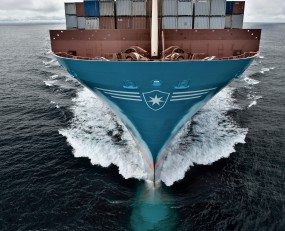
“An exceptionally strong performance” driven by “strong demand” that “led to bottlenecks and a lack of capacity and equipment, which drove up freight rates to record-high levels”. This is how Søren Skou, CEO of A.P. Moller – Maersk explained the company’s results for the first quarter of 2021.
The results were impressive, with the quarter seeing EBITDA (Earnings Before Interest, Debt and Amortisation) leap from $1.5bn in Q1 2020 to $4bn. Revenue was up 30% to $12.4bn. The company attributed the increased profits to “higher volumes”; however these were only up 5.7% whilst freight rates were up 35%. The real driver was the vessel utilisation rate which hit 93%.
How long can these buoyant conditions go on? It seems, looking at the capital markets day presentation that Maersk has just given, that the company thinks it will carry on in some form for several years. In presentations given to investors, the company stated that the container shipping business “is expected to deliver EBIT margins above 6%. Once the current exceptionally strong market has normalized, a level well above previous lows”.
The implication is that normality will return relatively quickly, but it will be a normality characterised by a stable but higher-priced market. The market volatility at present, driven in Skou’s words by “bottlenecks” are caused by changes in the patterns of demand as well as a shortage of ships and port space. It will take considerable time, possibly several years for sufficient ships to be built to assuage the shortage of capacity and it is very unclear what the geography of consumer demand will be in the near future. Therefore, it appears that Maersk’s “normalized” market may take some time to emerge.
Something similar applies in air freight where Frank Appel, CEO of DP-DHL commented on Thursday (May 6) that “we should assume regional flying will come back pretty rapidly, but intercontinental will still be on a significantly lower based so it could take until 2022 and maybe beyond before you see a full normalisation”. He continued saying “of course this helps companies like us who control 250 wide body-freighters”.
The near-term danger to the markets for air and sea freight is that high freight rates, shortage of capacity and congestion will continue even as demand recovers. This could lead to even greater price rises and deterioration of service quality.
Source: Transport Intelligence, May 11, 2021
Author: Thomas Cullen